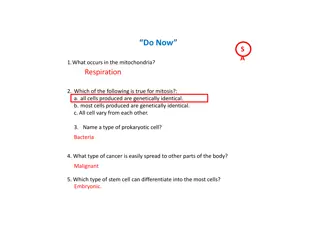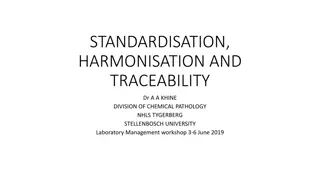Microbiology Laboratory Experiments Overview
This overview showcases various microbiology laboratory experiments conducted to examine the physiology of bacteria, enzymatic activities, and biochemical reactions. It includes experiments on Phenol Red Dextrose Broth, Phenol Red Lactose Broth, Nitrate Broth, Tryptone Broth, and more. The provided images and descriptions help identify bacterial species based on activities of microbes. The experiments involve observing color changes, enzyme production, and gas formation, offering insights into microbial characteristics and behaviors.
Download Presentation

Please find below an Image/Link to download the presentation.
The content on the website is provided AS IS for your information and personal use only. It may not be sold, licensed, or shared on other websites without obtaining consent from the author. Download presentation by click this link. If you encounter any issues during the download, it is possible that the publisher has removed the file from their server.
E N D
Presentation Transcript
Exp. 15: Physiology of Bacteria Exp. 15: Physiology of Bacteria I. I.
Purpose: activities of microbes that are frequently used to identify bacterial species. Purpose: To examine specific enzymatic Refer to Exp. 21, Table 9 & Figure 8, for biochemical reactions of various Gram neg. rods Inoculated last lab: Gram Neg. rods: E.coli, Enterobacter, Proteus Gram Pos. rod: Bacillus stearothermophilus
Phenol Red Dextrose Broth (PRDB): microbe ferment glucose or dextrose? Yellow with gas: + Phenol Red Dextrose Broth (PRDB): does the Yellow without gas: - Red with or without gas: - + + - - - - Yellow/red with or without gas: +/-
Phenol Red Lactose Broth (PRLB): microbe ferment lactose? Yellow with gas: + Phenol Red Lactose Broth (PRLB): does the Yellow without gas: - Red with or without gas: - + + - - - - Yellow/red with or without gas: +/-
Nitrate Broth: enzyme called nitratase? Nitrate Broth: Does the microbe produce an Nitrate Nitrite Nitratase ADD: ADD: 2-3 drops Nitrate A 2-3 drops Nitrate B development in 30sec. Mix; look for color
Nitrate Broth Nitrate Broth RESULTS: RESULTS: Peach/pink: + Not peach/pink: - - - + +
Tryptone an enzyme called tryptophanase? Tryptone Broth: Broth: Does the microbe produce Tryptophan Indole Tryptophanase ADD: ADD: 10-12 drops of Kovacs Reagent Mix; look immediately immediately for the reaction
Tryptone Tryptone Broth Broth RESULTS: RESULTS: Maroon top layer: + No maroon top layer: -
Methyl Red Methyl Red- - Voges Voges Proskauer Proskauer Broth (MRVP) Broth (MRVP) First pipette. Transfer of broth to a 2ndempty glass tube. Cap both tubes. One tube you will perform the Methyl Red Test and the 2ndthe Voges Proskauer Test First divide the tube in half using a Pasteur
Methyl Red Test: a large amount of acid end product from glucose fermentation? Methyl Red Test: Does the microbe produce Glucose pH below 4.4 ADD: ADD: 4 drops of Methyl Red Reagent Mix; look immediately immediately for the reaction
Methyl Red Test Methyl Red Test RESULTS: RESULTS: Pink: + Not Pink: -
Voges produce a compound called acetoin during glucose fermentation? Voges Proskauer Proskauer Test: Test: Does the microbe Glucose Acetoin ADD: ADD: 18 drops of Barritts A Reagent and 18 drops of Barritts B Reagent Mix tube well return tube to rack and look periodically over the next 50 minutes for a pos. reaction. Do not reshake Mix tube well & let stand for 10 minutes. If neg., Do not reshake tube. tube.
Voges Voges Proskauer Proskauer Test Test RESULTS: RESULTS: Top maroon/pink film Film NOT maroon/pink: - film: +
Simmons utilize citrate as a source of carbon? Simmon s Citrate Test: Citrate Test: Does the microbe The Simmons Citrate slant contains citric acid and bromothymol blue (green when acidic). When citrate is utilized, the pH increases to 7.6 and bromothymol blue turns blue.
Simmons Simmon s Citrate Test Citrate Test RESULTS: surface RESULTS: Observe for color change on the surface of the slant Blue slant: + Green slant: - - - + +
Hydrolysis of Urea: produce an enyzme called urease that breaks down urea? Hydrolysis of Urea: Does the microbe Urea Broth tube contains urea and phenol red. When urea is broken down to CO2& ammonia, the pH increases to 8.4 and phenol red turns to a magenta/purple color. Urea Ammonia (pH 8.4)
Hydrolysis of Urea Hydrolysis of Urea RESULTS: : Observe for a color change Magenta/purple: + Not magenta/purple: - RESULTS - - + +
Production of Hydrogen Sulfide (H the microbe produce H2S when decomposing proteins? Production of Hydrogen Sulfide (H2 2S): S): Does TSI Tube three sugars and iron. Only analyzing the tube for H2S production which is indicated by a black coloration (any amount) in the butt or bottom of the tube. TSI Tube must be stabbed. The tube contains
Hydrogen Sulfide (H Hydrogen Sulfide (H2 2S) Test S) Test RESULTS: RESULTS: Black color in butt/bottom of tube: + No back color in butt/bottom of tube: - - - - - + + - -
Hydrolysis of Starch: produce an exoenzyme called amylase that breaks starch into maltose? Hydrolysis of Starch: Does the microbe amylase Starch + + IKI IKI Maltose Brown Clear
Hydrolysis of Starch Hydrolysis of Starch ADD: ADD: Flood the plate with iodine or IKI. Observe for a clearing around colony. Clear halo surrounding colony: + Brown color surronding colony: -
Exp. 16: Identification of Unknown Microorganisms Exp. 16: Identification of Unknown Microorganisms I. I.
Purpose: unknown microorganisms by using various test methodologies. Purpose: To determine the identity of TODAY: Set up Temperature Study (Exp. 7): Set up Colony Morphology Plate Do a Wet Mount: Do a Simple Stain: Do a Gram Stain: TODAY: Set up Temperature Study (Exp. 7): 5, 25, 37, 60oC Set up Colony Morphology Plate Do a Wet Mount: motility & size Do a Simple Stain: cocci, rod or large ovoid cells Do a Gram Stain: Gram + or -; shape
Gram Stain Yeast Gram Neg.Rod Gram Pos. Cocci























